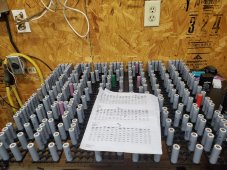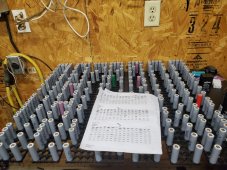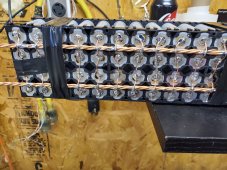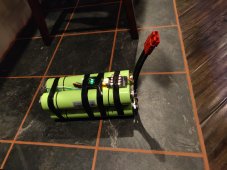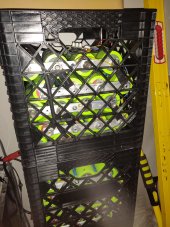You are using an out of date browser. It may not display this or other websites correctly.
You should upgrade or use an alternative browser.
You should upgrade or use an alternative browser.
32650 lifepo4 cells vs 280 ah cells
- Thread starter OffGrid
- Start date
More potential points of failure and complexity is what springs to mind (not that you couldn't do it).
For 500Ah wouldn't you need something like 80-100 cells in parallel?
Is this just a thought experiment or is there a reason you are looking at 32650s? If you are seriously considering them what attracts you to this approach?
For 500Ah wouldn't you need something like 80-100 cells in parallel?
Is this just a thought experiment or is there a reason you are looking at 32650s? If you are seriously considering them what attracts you to this approach?
OffGrid
Solar enthusiast
- Joined
- Sep 21, 2019
- Messages
- 72
I'm just thinking on it ! Im planning on building a few 20 ah packs with them. But as far as why they attract me , I just really like the way they look in big packs, lol .. but I've also been watching some of the threads on 280 ah cells and I'm starting to see a pattern of too many sketchy cells.
BarkingSpider
Carbon Lifeform
For small batteries the 32650 are the way to go. Big batteries 280ah. You decide.
Ampster
Renewable Energy Hobbyist
No, you are only limited by your imagination and how many volts you need. I built a lot of ebike batteries with Headways and almost considered them for an EV. That was eight years ago and then I got a really good deal on some prismatics. Comparing the price per kWh of the ones in the link to the 280 Ahr cells the prices are very close. But as someone posted earlier if you want a big pack of 48 volts or more the construction time and form factor might favor the large prismatics.Is there any reason I couldn't get 500 amp hours out of 32650
Old Post, but still Highly Relevant:What are the pros and cons of using 32650 cells vs the bigger cells . I know there is a lot more work in the the 32650 cells . Is there any reason I couldn't get 500 amp hours out of 32650
32650 is a more advanced project. Benefits are Better continuous discharge 3C normal, 6C already exists. Also, more reliability. If one cell goes down, the voltage does not fluctuate, the other cells pick up the slack. Because you would have over 10P parallel.
Prismatic have longer lifecycles, but they are rated to .5C and recently 1 C is normal continuous discharge. Prismatics are the industry standard for Ev, and are also used in over 10P on those platforms. To improve reliability.
The Problem for cylindrical cells for DIY is that you need very good Spotwelding skills. to obtain a reliable connection.
Prismatic are just easier to slap a bolt and solar application are perfect for them bc usually is a < 0.5C discharge.
Hope this Helps.
RCinFLA
Solar Wizard
- Joined
- Jun 21, 2020
- Messages
- 3,566
For a DIY'er less complexity is better. Small cells in parallel have to be carefully matched and very consistent interconnects.
IMO, folks making power walls from hundreds of salvaged 18650 LiPo cells are asking for a Chernobyl-like incident.
IMO, folks making power walls from hundreds of salvaged 18650 LiPo cells are asking for a Chernobyl-like incident.
*salvaged 18650 are not LiPo, they are Li-ion, and yes they have failed spectacularly.For a DIY'er less complexity is better. Small cells in parallel have to be carefully matched and very consistent interconnects.
IMO, folks making power walls from hundreds of salvaged 18650 LiPo cells are asking for a Chernobyl-like incident.
I would say that for a small pack (think scooter, or e-bike) use the cylindrical cells because of their form factor, it's also much easier to get a higher voltage in a small package with the smaller size cells. A 20ah pack is well within what I would considered to be a reasonable 32650 pack, 4p4s maybe. Even so, I would probably use the 25ah TopBand cells instead, no soldering or spot welding required. A 500 ah pack made with cylindrical cells would be a ridiculous undertaking without professional manufacturing equipment. Possible? Sure, but there's so many potential points for failure it's not worth it to me.
NVS
Solar Enthusiast
- Joined
- Sep 14, 2021
- Messages
- 372
I built a 312ah 24v battery out of 840 lithium ion 18650 cells so it can be done. I bought the cells for $0.50 each. I capacity tested each cell then built 7 balanced packs of 120 cells each. I built my own spot welder from a car battery.
Attachments
Nobodybusiness
Collecting the leftovers of the Great Sky Reactor.
That my friend is a lot of work. Looks nice though..I built a 312ah 24v battery out of 840 lithium ion 18650 cells so it can be done. I bought the cells for $0.50 each. I capacity tested each cell then built 7 balanced packs of 120 cells each. I built my own spot welder from a car battery.
OffGrid
Solar enthusiast
- Joined
- Sep 21, 2019
- Messages
- 72
I used prismatic cells in my build. They are still working great. But I build small 12 to 20 ah packs from 32650 cells . I just like building with them.Old Post, but still Highly Relevant:
32650 is a more advanced project. Benefits are Better continuous discharge 3C normal, 6C already exists. Also, more reliability. If one cell goes down, the voltage does not fluctuate, the other cells pick up the slack. Because you would have over 10P parallel.
Prismatic have longer lifecycles, but they are rated to .5C and recently 1 C is normal continuous discharge. Prismatics are the industry standard for Ev, and are also used in over 10P on those platforms. To improve reliability.
The Problem for cylindrical cells for DIY is that you need very good Spotwelding skills. to obtain a reliable connection.
Prismatic are just easier to slap a bolt and solar application are perfect for them bc usually is a < 0.5C discharge.
Hope this Help
newbostonconst
Solar Enthusiast
- Joined
- Sep 24, 2019
- Messages
- 1,005
I have done 6 packs using 60280 (96 cells)....4 (5P5S) packs and 2 (4S) packs for starter jump packs and running cars and my cat backhoe, also a small prismatic pack for my motorcycle. Plus a 20 cell 280ah pack....when not using my batteries for odd stuff the majority of the time they are hooked to my house bank.
The cylindrical cells holdup better and don't expand. I have expanded 2 of my 280 cells going over voltage for a short period. 60280's dont/cant do that as easy.
do that as easy.
The cylindrical cells holdup better and don't expand. I have expanded 2 of my 280 cells going over voltage for a short period. 60280's dont/cant
Attachments
Last edited:
svetz
Works in theory! Practice? That's something else
The Peak Jump Start project was built with 32700s, speaking of which, probably time to see how it's doing (been sitting in the closet the last couple of months waiting for hurricane season).
newbostonconst
Solar Enthusiast
- Joined
- Sep 24, 2019
- Messages
- 1,005
My bad....thanks.....fixedThose looke like 60280 cells
The screw terminals and bus bars make this much more appealing to me than having to spot weld.I have done 6 packs using 60280 (96 cells)....4 (5P5S) packs and 2 (4S) packs for starter jump packs and running cars and my cat backhoe, also a small prismatic pack for my motorcycle. Plus a 20 cell 280ah pack....when not using my batteries for odd stuff the majority of the time they are hooked to my house bank.
The cylindrical cells holdup better and don't expand. I have expanded 2 of my 280 cells going over voltage for a short period. 60280's dont/cantdo that as easy.
Yes. Though these cells for the most part came from Battery Hookup as far as most people here using them. As a result, not all have the proper nuts on the anode and cathode (I had one box of 8 come with no nuts) The positive terminal has an Aluminum nut, while the negative is plated steel. I have 320 of these cells that I’ve half assembled at this point (1 bank of 10p16s). Sourcing AL M12x1.25 nuts is challenging!The screw terminals and bus bars make this much more appealing to me than having to spot weld.
Not all 32650's are the same. As we know, things like 18650, 32650, 32700 are mere *size* designators, not chemistry designators, but you'll often see "I built a pack with 18650's" and it burned up.. Need to check if the op knows the difference in LI chemistries.
Also, cells differ on their power vs energy capabilities and one should look that up. For instance, the 32650's (or 32600's) in my Talentcell, are far different from those inside a BattleBorn. Basically, mine inside are gigantic solar walkway cells, where high-C performance is not the design goal.
The cells inside the Talentcell are designed for longer-term slow(er) charge and discharge than a BattleBorn cell. It isn't the choice of a cheaper bms - the cells themselves have this limitation. You can look up specs typical on the BatterySpace site for example.
On the flip side, using Headway cells - a frequent favorite in the past for high-C applications, would be totally inappropriate for a bedside cpap machine. (well, just more expensive than it had to be)
But yes, either way, the use of cylindrical vs prismatic means no need to compress to maintain their safety-valve psi in case of catastrophic failures, and no delamination of anode/cathode alignment, where dendrites and micro-shorts like to form.
These days, if I was inclined to use cylindricals, I'd stick to one of the better manufacturers like BattleBorn. Or Talentcell. Just choose the one right for your application.
Ah brings back the bad old days of guys soldering counterfeit / gray market A123 rejects together in an unsafe manner and calling it a day....
Also, cells differ on their power vs energy capabilities and one should look that up. For instance, the 32650's (or 32600's) in my Talentcell, are far different from those inside a BattleBorn. Basically, mine inside are gigantic solar walkway cells, where high-C performance is not the design goal.
The cells inside the Talentcell are designed for longer-term slow(er) charge and discharge than a BattleBorn cell. It isn't the choice of a cheaper bms - the cells themselves have this limitation. You can look up specs typical on the BatterySpace site for example.
On the flip side, using Headway cells - a frequent favorite in the past for high-C applications, would be totally inappropriate for a bedside cpap machine. (well, just more expensive than it had to be)
But yes, either way, the use of cylindrical vs prismatic means no need to compress to maintain their safety-valve psi in case of catastrophic failures, and no delamination of anode/cathode alignment, where dendrites and micro-shorts like to form.
These days, if I was inclined to use cylindricals, I'd stick to one of the better manufacturers like BattleBorn. Or Talentcell. Just choose the one right for your application.
Ah brings back the bad old days of guys soldering counterfeit / gray market A123 rejects together in an unsafe manner and calling it a day....
Similar threads
- Replies
- 1
- Views
- 304
- Replies
- 7
- Views
- 313
- Replies
- 5
- Views
- 299



